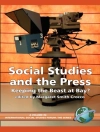Now with SAGE Publishing!
In a first-of-its-kind format,
Cultural Anthropology: A Problem-Based Approach is organized by problems and questions rather than topics, creating a natural discussion of traditional anthropological concerns such as kinship, caste, gender roles, and religion. This brief text promotes critical thinking through meaningful exercises, case studies, and simulations. Students will learn how to analyze their own culture and gain the tools to understand the cultures of other societies. The
Eighth Edition has been thoroughly updated and reorganized to emphasize contemporary issues around social and economic inequality, gender identity, and more.
Included with this title:
The password-protected Instructor Resource Site (formally known as SAGE Edge) offers access to all text-specific resources, including a test bank and editable, chapter-specific Power Point® slides.
Innehållsförteckning
Preface
Acknowledgments
About the Authors
Chapter 1. Culture and Meaning
Problem 1: How Can People Begin to Understand Beliefs and Behaviors That Are Different From Their Own?
Introduction: The World Behind Everyday Appearances
Question 1.1: Why Do Human Beings Differ in Their Beliefs and Behaviors?
Question 1.2: How Do People Judge the Beliefs and Behaviors of Others?
Question 1.3: Is It Possible to See the World Through the Eyes of Others?
Question 1.4: How Can the Meanings That Others Find in Experience Be Interpreted and Described?
Question 1.5: What Can Learning About Other Peoples Tell Americans About Themselves?
Case Study in Doing Anthropology #1: Why We Post
Conclusions
References and Suggested Readings
Chapter 2. The Meaning of Progress and Development
Problem 2: How Do We Explain the Transformation of Human Societies Over the Past 10, 000 Years From Small-Scale Nomadic Bands of Hunters and Gatherers to Large-Scale Urban-Industrial States?
Introduction: The Death of a Way of Life
Question 2.1: Why Did Hunter-Gatherer Societies Switch to Sedentary Agriculture?
Question 2.2: Why Are Some Societies More Industrially Advanced Than Others?
Question 2.3: Why Do Poor Countries Not Modernize and Develop in the Same Way as Wealthier Countries?
Question 2.4: How Do Modern Standards of Health and Medical Treatment Compare With Those of Traditional Societies?
Question 2.5: Why Are Simpler Societies Disappearing?
Case Study in Doing Anthropology #2: Searching for the Perfect Diet and Doing Development
Conclusions
References and Suggested Readings
Chapter 3. Debt, Globalization, and the Nation-State
Problem 3: How Does Our Economy Affect Our Way of Life?
Introduction: Debt
Question 3.1: How Is Money Created and Why Must Modern Economies Perpetually Grow?
Question 3.2: Where Does the Wealth Needed to Sustain Growth Come From?
Question 3.3: What Kind of Economic System Is Necessary to Sustain Growth?
Question 3.4: What Is the Role of the Nation-State in Sustaining Growth?
Question 3.5: Why Do Economies Collapse?
Case Study in Doing Anthropology #3: Anthropology and Public Policy
Conclusions
References and Suggested Readings
Chapter 4. The Cultural Construction of Social Hierarchy
Problem 4: Why Are Modern Societies Characterized by Growing Economic Inequalities?
Introduction: Plutocracy
Question 4.1: How Unequal Are We?
Question 4.2: Why Is Social and Economic Inequality Increasing?
Question 4.3: How Do People Come to Accept Social Hierarchies as Natural?
Question 4.4: How Do People Living in Poverty Adapt to Their Condition?
Question 4.5: What Are the Effects of Inequality on Society?
Case Study in Doing Anthropology #4: Health and Human Rights
Conclusions
References and Suggested Readings
Chapter 5. The Social and Cultural Construction of Reality
Problem 5: Why Do People Believe Different Things, and Why Are They So Certain Their View of the World Is Correct and Other Views Are Wrong?
Introduction: The Central Question
Question 5.1: How Does Language Affect the Meanings People Assign to Experience?
Question 5.2: How Does Symbolic Action Reinforce a Particular View of the World?
Question 5.3: How Do People Come to Believe What They Do, and How Do They Continue to Hold to Their Beliefs Even If They Seem Contradictory or Ambiguous?
Question 5.4: How Can We Account for the Different Meanings People Assign to Experiences?
Question 5.5: How Can People Reorder Their View of the World If It Becomes Unsatisfactory?
Case Study in Doing Anthropology #5: Political Consulting and the Power of Metaphor
Conclusions
References and Suggested Readings
Chapter 6. Patterns of Family Relations
Problem 6: What Do We Need to Know Before We Can Understand the Dynamics of Family Life in Other Societies?
Introduction: Soap Operas and Family Relations
Question 6.1: What Is the Composition of the Typical Family Group?
Question 6.2: How Are Families Formed and Ideal Family Types Maintained?
Question 6.3: What Are the Roles of Sexuality, Love, and Wealth?
Question 6.4: What Threatens to Disrupt the Family Unit?
Case Study in Doing Anthropology #6: Combating HIV/AIDS
Conclusions
References and Suggested Readings
Chapter 7. The Cultural Construction of Identity
Problem 7: How Do People Determine Who They Are, and How Do They Communicate Who They Think They Are to Others?
Introduction: The Importance of Self
Question 7.1: How Does the Concept of Personhood Vary From Society to Society?
Question 7.2: How Do Societies Distinguish Individuals From One Another?
Question 7.3: How Do Individuals Learn Who They Are?
Question 7.4: How Do Individuals Communicate Their Identities to One Another?
Question 7.5: How Do Individuals Defend Their Identities When They Are Threatened?
Case Study in Doing Anthropology #7: Fat Talk
Conclusions
References and Suggested Readings
Chapter 8. The Cultural Construction of Violent Conflict
Problem 8: How Do Societies Give Meaning to and Justify Collective Violence?
Introduction: The Justification of Violent Conflict
Question 8.1: How Do Societies Create a Bias in Favor of Collective Violence?
Question 8.2: How Do Societies Create a Bias Against Violent Conflict?
Question 8.3: What Are the Economic, Political, or Social Differences Between Peaceful and Violent Societies?
Question 8.4: What Are the Effects of War on Societies?
Question 8.5: How Is It Possible to Justify the Creation of Weapons of Mass Destruction?
Case Study in Doing Anthropology #8: The Uses (and Misuses?) of Anthropology for Peace and War
Conclusions
References and Suggested Readings
Glossary
References
Index












